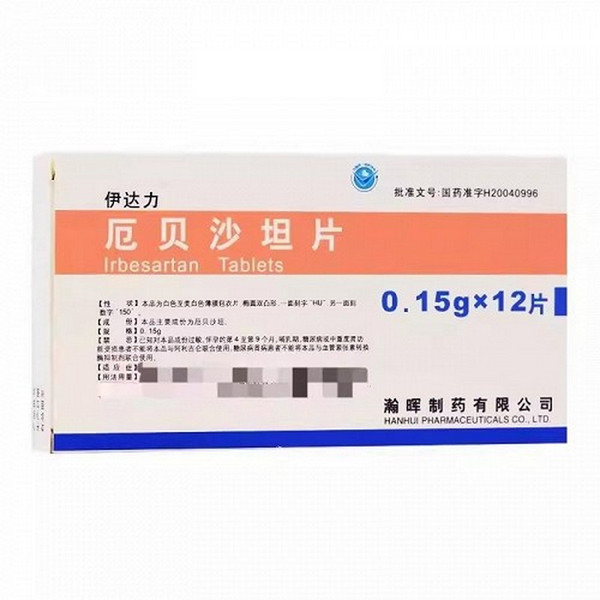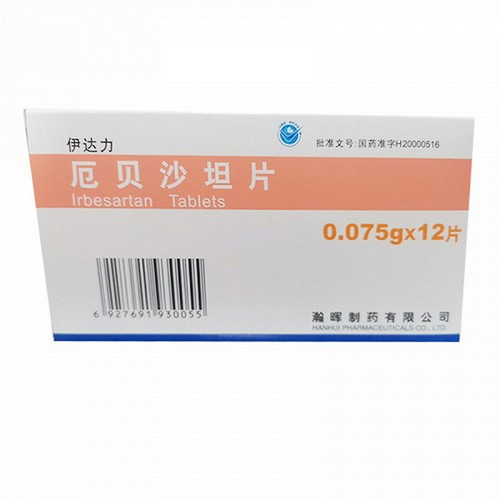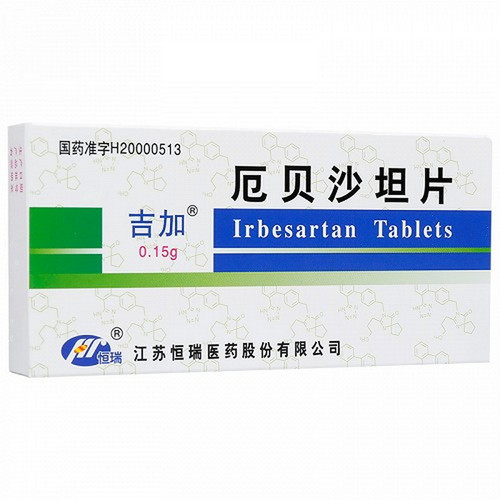Product Overview
[Drug Name]
Generic Name: Irbesartan Tablets
Trade Name: YiDaLi Irbesartan Tablets 0.15g*12 Tablets
Pinyin Code: YiDaLiEBeiShaTanPian 0.15g*12 Tablets
[Main Ingredient]
The main ingredient of this product is irbesartan.
[Properties]
This product is a film-coated tablet that appears white or off-white after removal of the coating.
[Indications/Main Functions]
Treatment of essential hypertension. Treatment of type 2 diabetic nephropathy with hypertension.
[Specifications]
0.15g*12 Tablets
[Dosage and Administration]
Oral: The recommended starting dose is 0.15g once daily. Depending on the condition, it can be increased to 0.3g once daily. It can be used alone or in combination with other antihypertensive medications. For severe hypertension or when blood pressure remains unsatisfactory after increasing the dose, a small dose of a diuretic (such as a thiazide) or other antihypertensive medication can be added. [Adverse Reactions]
Common adverse reactions include headache, dizziness, palpitations, and occasional cough. These reactions are generally mild and transient, and most patients tolerate continued medication well. Urticaria and angioedema are rare. Literature reports of adverse reactions with an incidence greater than 1% for this product include: dyspepsia, heartburn, diarrhea, skeletal muscle pain, fatigue, and upper respiratory tract infection, but these reactions were not significantly different from the control group. Other adverse reactions with an incidence greater than 1% but lower than the control group include abdominal pain, anxiety, nervousness, chest pain, pharyngitis, nausea and vomiting, rash, and tachycardia. The incidence of hypotension and orthostatic hypotension is approximately 0.4%.
[Contraindications]
This product is contraindicated in patients with allergies.
[Drug Interactions]
1. When using this product with diuretics, be aware of hypovolemia or hyponatremia, which may cause hypotension. When used with potassium-sparing diuretics (such as triamterene), avoid increasing serum potassium. 2. This product has no significant interaction with warfarin. 3. Concomitant use with digitalis drugs such as digoxin, beta-blockers such as atenolol, and calcium antagonists such as nifedipine does not affect the pharmacokinetics of these drugs.
[Precautions]
1. Correct any hypovolemia and/or sodium depletion before initiating treatment. 2. Patients with renal insufficiency may require a reduced dose of this drug. Also, monitor changes in blood urea nitrogen, serum creatinine, and potassium. As a result of renin-angiotensin-aldosterone inhibition, some sensitive patients may experience changes in renal function. 3. No dose adjustment is required for patients with hepatic insufficiency or the elderly. 4. Irbesartan cannot be excreted through hemodialysis. Please read the package insert carefully and use as directed by your doctor.
[Pediatric Use]
No safety data are available for patients under 18 years of age.
[Elderly Use]
This has not yet been determined.
[Overdose]
Overdose with this drug may cause hypotension, tachycardia, or bradycardia. Induce vomiting, gastric lavage, and supportive care should be employed.
[Pharmacology and Toxicology]
According to international reports, this drug is rapidly absorbed after oral administration, with a bioavailability of 60-80%, unaffected by food. Peak plasma concentrations are reached in 1-1.5 hours, with an elimination half-life of 11-15 hours. Steady-state is achieved within three days. Irbesartan is metabolized by glucuronidation or oxidation, with in vitro studies demonstrating that oxidation is primarily by cytochrome P450 2C9. Irbesartan and its metabolites are excreted via the bile duct and kidneys. Irbesartan is 90% plasma protein bound. According to domestic data, after oral administration of 300 mg of this drug to healthy subjects, peak plasma concentrations reach approximately 4058 μg/L approximately 1.9 hours later, with an elimination half-life (t1/2β) of approximately 10.2 hours.








